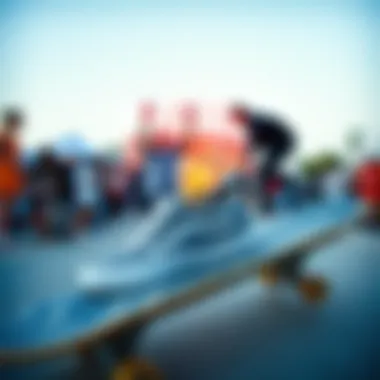The Rise of Vans: Skateboarding's Iconic Brand


Intro
In the tapestry of skateboarding, few brands stand out like Vans. From its humble beginnings to the role it plays in today's skate culture, Vans has cemented its status as more than just a shoe manufacturer; it’s a heartbeat of the skateboarding community. This article will dive into the journey of Vans, mapping out the brand’s origins, its pivotal role in creating and fostering skateboarding culture, and how it has adeptly adapted to the whims of time.
Vans began its adventure in 1966 when it started making shoes for skateboarders in California. As the skateboarding scene took off, so too did the brand’s popularity. Over the years, Vans has been on quite an odyssey, aligning itself not only with the sport but also embodying the spirit of rebellion, creativity, and self-expression that defines skateboarding.
What separates Vans from its competitors is not merely effective marketing, but genuine engagement with the skateboard community. This goes beyond just selling shoes; it’s about connection, authenticity, and the common ground that binds skaters together. We will explore how Vans has managed to stay relevant across generations while continually inspiring new waves of skaters. All of this together paints a vivid picture of a brand that understands its roots deeply while looking forward to the future.
Let’s take a closer look at the distinctive elements that contributed to the rise of Vans within skateboarding culture. From the techniques on the board to the social aspects that have flourished around the skating lifestyle, each piece of the puzzle tells a story.
Prelude to Vans
The emergence of Vans as a pivotal player in skateboarding culture marks a fascinating chapter in the narrative of youth subcultures and brand evolution. Understanding Vans involves more than just recognizing its logo emblazoned on shoes; it encapsulates the values of creativity, self-expression, and community that lie at the heart of skateboarding. Vans has transitioned from a local shoe manufacturer to a globally recognized brand, rooted in the spirit of skateboarding.
This introductory section discusses the fundamental aspects of Vans, pivotal in framing the entire exploration of the brand's influence. The mission that drives Vans goes far beyond profit margins; it speaks to fostering a community of skaters, artists, and fans who resonate with its ethos. Only by delving into the company’s history and core principles can one truly appreciate why Vans remains a staple for skaters of all ages.
Historical Background
Vans was established in 1966 in Anaheim, California, by the Van Doren brothers alongside partners James and Paul Van Doren. Initially, the company began by manufacturing shoes for the local marketplace. At that time, the skateboarding scene was just starting to flicker into life, primarily consisting of surfers who sought alternative ways to ride on land. The shoes provided by Vans, with their durable canvas and rubber soles, fit the bill perfectly for this burgeoning movement.
By the 1970s, the brand captured the hearts (and feet) of skaters in Southern California with their iconic "Authentic" sneaker. With a minimalist design and timeless appeal, they quickly became a favorite for their functionality and aesthetic.
Mission and Vision
Vans positions itself as a brand that celebrates the spirit of action sports, creativity, and self-expression. The company's mission emphasizes inclusivity, asserting that "Vans is for all those who participate in youth culture". The vision extends beyond just footwear: it's about building a platform for creativity and community. This idea of fostering inclusivity resonates throughout its initiatives, aimed at empowering the next generation of skaters and artists.
The commitment to supporting not only the skateboarding community but also the artistic pursuits of individuals sets Vans apart from many mainstream brands. This unique vision reflects an understanding that skateboarding is more than just a sport; it's a culture where creativity thrives.
Vans achieves its mission through various avenues, including sponsoring athletes, hosting events, and collaborating with artists and designers to create limited-edition footwear. The brand's mantra encourages authenticity, urging individuals to stay true to themselves, which resonates powerfully among its diverse audience. As skateboarding continues to evolve, Vans, with its roots firmly planted in the culture, is poised to ride the wave of innovation and continue shaping the future.
The Founding of Vans
The genesis of Vans is not just a tale of vision and entrepreneurship; it is a narrative intertwined with the very fabric of skateboarding culture. Established in 1966 by Paul Van Doren and his partners, the brand set foot in the arena of footwear with one clear objective: to create durable shoes for an active lifestyle. That humble beginning paved the way for Vans to become a linchpin in skateboarding, transforming not only how skaters dress but also how they express themselves on and off the board.
The Initial Launch
The initial launch of Vans was marked by a distinctive strategy that distinguished it from contemporaries. Rather than lean on traditional retail channels, the founders opted to sell their shoes directly to customers. This hands-on approach honed the connection with the local community, specifically surfers and skateboarders in California.
Offering a unique service wherein customers could choose the styles, colors, and patterns of their shoes, Vans immediately resonated with the youth culture of the time. The response was not just positive; it was electric. Within a few months, the company was rolling out its first flagship store in Anaheim, California, a hotspot for skaters.
- Initial Product Line: The flagship Vans model, known as the #44 Deck Shoe, was released and became an immediate favorite. It was slim, flat, and, most importantly, utilized a sticky rubber sole that provided the grip needed for skateboard tricks.
- Market Adaptation: The Vans brand quickly adapted to feedback from athletes, leading to further product iterations that better addressed the needs of skaters.
This grassroots approach not only cultivated a loyal customer base but also established Vans as a brand that truly understood the lifestyle of its wearers.
Early Design Innovations
In a space where functionality and aesthetics often clash, Vans carved a niche with its early design innovations that have since become benchmarks in skate footwear. The brand didn’t just create shoes; it crafted tools for performance.
One notable innovation was the introduction of the waffle sole. A design feature that many take for granted today, the waffle sole provided skaters with unmatched grip and board feel. This innovation directly influenced how tricks were executed and laid the groundwork for performance criteria that skaters would come to demand from their footwear.
- Customizable Options: Vans also recognized the power of self-expression. Early on, they allowed skaters to personalize their footwear, leading to unique designs that reflected individual styles. Color choices and patterns became an extension of the skater’s identity.
- Durability and Comfort: The materials used were specifically selected for their durability, helping skaters cope with the rigorous demands of their sport. For instance, the utilization of canvas and suede not only ensured longevity but also allowed for a good fit that enhanced comfort during long skate sessions.
In these formative years, it was clear that Vans was not merely a footwear manufacturer but a brand that laid the groundwork for an entire culture, marrying form and function in ways that resonated deeply with its audience.
"Vans, at its core, has always been a reflection of the voices and creativity of the skaters who wear them. The founders didn’t just make shoes; they created a platform for self-expression within the skateboarding community."
This innovative approach did not go unnoticed, setting the stage for Vans to evolve as a central player in both skateboarding culture and the broader landscape of lifestyle fashion.
Vans and Skateboarding
Vans has become synonymous with skateboarding. The connection between the brand and this rebellious sport runs deep, representing more than just footwear; it embodies a lifestyle, a culture, and even an attitude toward life itself. Delving into the significance of Vans in skateboarding isn't merely about shoes. It's about understanding how the brand carved a niche that resonated with skaters and non-skaters alike, enveloping itself in the very fabric of skate culture.


From its inception, Vans identified the needs of skaters: durable materials, comfortable fit, and a style that resonated with their identity. This attention to detail in the design process made each pair more than just a product — they symbolized an allegiance to a community. Vans didn’t just want to sell shoes; they sought to enhance the skating experience.
The Brand's Entry into Skate Culture
Vans made its first significant move into the skateboarding world during the early 1970s. This came shortly after the brand was founded in 1966 - a time when skateboarding was still in its infancy. It was in California, amidst sun, surf, and a budding skate scene that Vans found its foothold. A watershed moment occurred when the company introduced their now-iconic Authentic model, a shoe that would soon become a staple for skaters.
But to understand how Vans entered skate culture, one must look at the broader socio-cultural milieu of the time. Skating was more than just a sport; it was an expression for youth, a mark of independence. Vans tapped into this narrative seamlessly. By hosting events, collaborating with local skating legends, and even giving skaters the freedom to customize their shoes, Vans ensured its shoes were not just worn, but celebrated.
In the mid-1970s, Vans took a giant leap forward by introducing their skateboard-specific line, complete with features that addressed the skateboarders’ fierce requirements. This set them apart from competitors, aligning Vans not just as an option but as a necessary element of a skater’s gear.
Sponsorships and Team Development
As the skateboarding boom of the 1980s took off, Vans doubled down on their commitment to the skating community through sponsorships and team development. The brand didn't merely throw money at skaters; they crafted relationships grounded in respect and shared passion.
Vans understood that the authenticity of its brand hinged on working with true skateboarders. They built a team that included some of the most influential names in the sport. Each sponsorship was less about capitalizing on a market, and more about elevating the sport and fostering its growth.
This focus on nurturing talent has borne fruit. Partners like Tony Hawk, who would later become a household name, helped cement Vans’ place in skate history. By supporting events like the Vans Warped Tour and local competitions, they ushered in a renaissance of skateboarding as a mainstream sport while keeping the grassroots spirit alive.
"Skateboarding isn't just about the trick or the grind. It's a feeling, and Vans gets that. When you put on a pair, you’re ready to embrace the road ahead."
The importance of these sponsorships extends beyond the athletes. They act as cultural touchstones. Communities rally around sponsored skaters, creating local scenes and fostering an environment where new talent can blossom. By continually backing events and competitions, Vans reinforces its commitment not just to the individuals, but to skateboarding as a whole.
In summary, Vans' definitive connection with skateboarding stems from a richly woven narrative of innovation, partnership, and community engagement. As they crafted their legacy, they laid the groundwork for future generations of skaters, speaking volumes about the brand’s dedication to the sport.
Design Elements of Vans Footwear
The essence of Vans footwear is more than just style; it's steeped in practical design that has made it a favorite among skateboarders. From the very onset, Vans has carved out a niche that speaks to both function and fashion. Its unique design elements cater not only to the aesthetics sought by consumers but also prioritize the physical demands skaters face on the board.
Classic Styles and New Releases
When one thinks of Vans, iconic silhouettes come rushing to mind. The Old Skool, for instance, is a staple—not just for its recognizable jazz stripe but for its durability and comfort. Initially launched in the 1970s, this model set the stage for what skate shoes should embody. Its canvas and suede combination ensures breathability while resisting wear and tear, crucial when executing stunts on the pavement.
Vans doesn’t stop at the classics, though. In recent years, they’ve injected fresh life into their lineup with collaborations and innovative releases that catch the eye of both seasoned skaters and newcomers alike. Models like the Vaiyn skate shoe, with its enhanced grip and refined aesthetics, show Vans' commitment to evolving with the times while staying true to their roots.
The blending of heritage with modern trends speaks volumes about Vans' understanding of its community—skaters appreciate a classic but are also drawn to novelty that reflects current styles. The balance between nostalgia and contemporary design is a testament to the brand’s awareness of the fashion landscape.
Functional Features for Skaters
Functionality is the name of the game when it comes to Vans footwear.
- Cushioning: Many vans models incorporate UltraCush™ technology, offering impressive impact protection. This feature is crucial for skaters who frequently land heavy tricks.
- Grip: The signature Waffle outsole isn’t just a design choice; it provides unparalleled grip that skaters count on when navigating tricky terrain or executing complicated flips.
- Durability: Vans uses reinforced stitching and high-abrasion materials in strategic areas, ensuring that shoes can withstand rigorous skate sessions. This attention to detail means fewer shoe replacements for serious skaters, which matters in a culture where performance and longevity are paramount.
"Vans are built for the grind, literally and figuratively; their shoes are not just about looking good, they keep you grounded on your board."
Vans’ commitment to providing skaters with footwear that meets their specific needs cannot be overstated. Each design feature is carefully considered, making them a trusted choice in the skateboarding community.
In summary, the design elements of Vans footwear encapsulate a blend of timeless style and innovation tailored to the skateboarder’s needs. With classic models serving as foundational pieces and new releases pushing the envelope of performance, Vans remains a dominant force in bridging the gap between skating culture and fashion.
Cultural Impact of Vans
The cultural impact of Vans within the skateboarding community cannot be overstated. This brand has not only been a staple in the footwear market but has also carved its niche deeply into the hearts of skaters around the globe. The significance of Vans extends beyond mere products; it embodies a lifestyle and an ethos that many aspire to adopt.
Vans' Influence on Skating Communities
Vans has become synonymous with skate culture, serving as a fundamental pillar that supports and uplifts various skateboarding communities. From deep ties with local shops to involvement in grassroots initiatives, the brand greatly amplifies the voices of skaters. Their sponsorships of rising talent and established professionals alike have helped shape the identity of modern skateboarding.
- Building Local Talent: Vans actively contributes to the development of local skate parks and supports events that give young skaters a platform. Programs that showcase local talent have resulted in the discovery of new stars in the skating world. One could say that Vans functions as a launchpad for ambitious skaters eager to make their mark.
- Community Engagement: Vans frequently engages in community outreach, often partnering with nonprofits to create inclusive skate environments. This not only fosters a sense of belonging but also makes skateboarding accessible to diverse age groups. This is critical in developing a supportive culture where everyone can participate.
This nest of community ties and support has turned Vans into more than just a shoe brand; it has established a familial bond with skaters, young and old. Many wear Vans not merely as a fashion statement, but as a badge of allegiance to a community that emphasizes creativity, freedom, and self-expression.
Vans in Popular Media


Vans has successfully leaped into the realm of popular media, allowing the brand to feel intertwined with skateboarding culture in a broader context. Through movies, music videos, and multimedia projects, Vans captures the essence of skating, resonating especially with the younger audience.
- Cinematic Presence: Whether it’s cameo appearances in iconic films or the focus in documentaries showcasing skater life, Vans has created memorable moments that resonate with the public. These portrayals often highlight challenges, triumphs, and the distinct aesthetic that skateboarding offers, allowing viewers to appreciate the culture's depth.
- Musical Collaborations: The brand doesn't shy away from music, either. Vans often partners with up-and-coming bands and established artists for exclusive events and promotions. These collaborations lend credence to its image as an integral part of youth culture. There's nothing quite like catching a new skate video filled with tricks while a Vans-laden soundtrack plays in the backdrop.
In numerous ways, Vans stands out in popular media as an icon that not only represents skateboarding but elevates it. This cultural crossover ensures that Vans remains relevant, tapping into the threads that link music, art, and sport.
"In the world of skating, wearing Vans is like carrying a piece of history with you; it's not just a shoe, it’s a statement of identity."
In examining Vans’ cultural reach, we find more than just a successful brand but a catalyst for unity and expression in skate communities worldwide. As Vans continues to grow, its legacy intertwines with the very fabric of skate culture, promising an exciting future for all those who tread the board.
Vans and Fashion Trends
Vans' evolution in the realm of fashion is not just a side note; it’s a testament to how a brand can transcend its original purpose and become an emblem of cultural significance. The marriage of skateboarding and fashion might not appear obvious at first glance, but Vans has skillfully navigated this complex landscape, solidifying its place in the heart of both communities. By understanding the intricate dynamics of fashion trends and skate culture, one sees how Vans plays a pivotal role in shaping youth identities.
Collaborations with Designers
One way that Vans has cemented its status in the fashion world is through strategic collaborations with renowned designers. This approach has allowed Vans to create limited-edition lines that resonate with both skaters and fashion enthusiasts alike. For instance, the collaboration with designer Matthew Williams brought forth a collection that fused functionality with avant-garde style. These partnerships serve not only to elevate the aesthetic appeal of Vans products but also to attract a wider audience, blurring the lines between streetwear and high fashion.
These collaborations often tap into the creativity of both the brand and the designer, resulting in unique designs that reflect contemporary trends. Additionally, the shoes crafted in these partnerships are designed to maintain their skateability, thus ensuring that they are as practical on the board as they are stylish off it.
Within this context, it’s interesting to note how such alliances can redefine brand perception. By working with visionary talents, Vans positions itself at the forefront of style without losing sight of its original ethos. Brands that walk this tightrope successfully often see a positive response from both their core audience and new customers who might have otherwise overlooked the brand.
Street Style Integration
Vans has effectively woven itself into the fabric of street style, a domain where expression reigns supreme and individuality is key. The versatility of Vans footwear—ranging from the classic Old Skool to the more contemporary slip-ons—has made them a staple in street fashion. This status is not merely incidental but the outcome of deliberate branding choices and marketing strategies.
The checkerboard pattern, for instance, has become a hallmark of the brand, attracting fashion-forward individuals who value both style and historical relevance. This print finds its way into various segments of street fashion, from casual outfits to more edgy styles, proving that Vans transcends the functional requirements of skateboarding.
Moreover, the brand’s understanding of social media’s role in modern fashion cannot be overstated. Influencers and street style icons frequently feature Vans in their posts, further embedding the shoes into the streetwear narrative. The way Vans focuses on these platforms, sharing user-generated content and engaging with followers, creates a compelling community that sees the brand as a staple, rather than just a product.
Community Engagement Initiatives
Community engagement initiatives play a pivotal role in the continuing ascent of Vans within skateboarding culture. These programs are not just marketing strategies; they are a fundamental part of how the brand interacts with its core audience. By supporting local skate parks and grassroots events, Vans nurtures a culture that values creativity, inclusivity, and collaboration among skaters of all ages and backgrounds.
Vans' Support for Local Skate Parks
Vans has consistently demonstrated its commitment to the skateboard community through direct support for local skate parks. The company understands that skateboarding isn't just a sport; it's a lifestyle, often rooted in specific neighborhoods and cultures. By partnering with community organizations and city governments, Vans contributes resources to build and maintain skate parks, which serve as vital hubs for local skaters.
- Benefits of Supporting Local Parks
- Access to Facilities: Local skaters gain a safe space to practice and showcase their skills.
- Growing the Community: When parks are well-maintained, they're more likely to attract new skaters, leading to a wider community.
- Sustainability of Skate Culture: By investing in infrastructure, Vans helps to ensure the longevity of skateboarding as a sport and culture.
This approach not only bolsters brand loyalty but also establishes Vans as more than a footwear company; it positions the brand as an advocate for the skater community.
Grassroots Programs and Events
Grassroots programs and events are indeed the lifeblood of Vans' community engagement. These initiatives give aspiring skaters the chance to participate in competitions, workshops, and art exhibits designed to amplify local talent. Vans often organizes contests that focus not just on skating prowess but also on creativity and self-expression, encouraging participants to showcase their unique styles and tricks.
- Types of Grassroots Programs
- Skill Development Workshops: These hands-on sessions teach young skaters essential techniques and safety skills.
- Sponsorship by Local Talent: Vans often signs local skaters to its sponsorship teams, promoting their stories and giving them a platform.
- Cultural Events: Vans sponsors art and music festivals that resonate with the skateboarding ethos. This fosters a culture of interconnectedness within the community.
Engagement through these means allows skaters to feel a sense of ownership and pride in their connection to Vans. It cements the brand's position not only as a leader in skateboarding footwear but also as a cornerstone of the skating lifestyle.
"Supporting local skate parks and grassroots initiatives is not just about skateboarding; it's about ensuring the culture thrives for future generations."
Such initiatives highlight the intersection of commerce and community, showing that Vans genuinely cares about more than just selling shoes. They advocate for the culture, investing in the people who build it every day.
Vans in the Digital Age
In today's world, where technology and culture intertwine like the threads in a well-worn pair of Vans, the brand’s embrace of the digital landscape cannot be overstated. Vans has utilized the internet and social media not merely as tools, but as integral parts of its identity. This transition appears as an evolution that reflects a deeper understanding of skateboarding communities, their preferences, and the transformative nature of digital marketing. By stepping into the digital age, Vans has solidified its place in the modern skate culture narrative, reaching enthusiasts and casual consumers alike.


Online Marketing Strategies
As the landscape of retail has changed, so too have the marketing strategies. Vans has been at the forefront, pioneering campaigns that resonate deeply with their audience. One of their standout moves has been creating compelling storytelling that aligns with the skate culture ethos. They're not just pushing shoes; they're selling a lifestyle—a passion that is palpable in every marketing campaign.
Key strategies include:
- Content Marketing: Vans has invested heavily in visual content that showcases skaters in action, allowing raw talent to speak for itself. This approach is welcoming for skaters and lends authenticity to their products.
- Influencer Collaborations: Partnering with well-known figures in skateboarding and beyond has amplified their reach. These figures often showcase Vans in natural settings, whether it's in a skate park or in urban landscapes, creating relatable touchpoints for fans.
- Email Campaigns: Engaging newsletters filled with stories, product launches, and promotions not only keep loyal customers informed but also create a sense of community. The personal touch makes readers feel seen and appreciated—a valuable connection in the modern age.
Engagement through Social Media
"> In the skateboarding world, social media serves both community-building and marketing purposes simultaneously. Vans has expertly navigated this dual function, turning platforms into vibrant hubs of interaction and creativity.
Social media channels have provided a space for skaters to share their progress, which in turn creates a feedback loop for Vans to engage with their audience. The brand has utilized Instagram, TikTok, and YouTube effectively to not just promote their products, but to foster a culture of inclusivity and creativity.
Their strategies involve:
- User-Generated Content: Encouraging fans to showcase their own skateboarding feats while donning Vans has yielded immense engagement. This community-driven content makes the brand feel less corporate and more like a shared experience among skaters.
- Interactive Campaigns: Vans often runs challenges, such as trick contests or video submissions, that not only ignite creativity among participants but also amplify brand visibility through shares and likes.
- Direct Communication: By utilizing stories and comments sections, Vans allows its audience to connect directly with the brand. This approach creates a feeling that the company listens, responds, and deeply values its customers.
Future Directions for Vans
As Vans progresses forward, examining its future directions is crucial for understanding how this iconic brand will continue its legacy within skateboarding culture. The brand’s adaptability is what has ensured its prominence over the decades. Thus, two specific aspects surface: sustainability and evolving consumer tastes. Both these pillars not only address the current cultural climate but also serve to anchor the brand firmly in the hearts of new and existing skaters.
Sustainability Efforts
Sustainability has become an essential topic in every industry today, and Vans is no exception. As climate change takes center stage, consumers expect brands to prioritize environmental consciousness. Vans has initiated several sustainability programs aimed at reducing its ecological footprint, which include eco-friendly materials in its footwear, such as organic cotton and recycled polyester.
In addition, the company is focusing on transparent supply chains and waste reduction in production processes. This commitment doesn’t just appeal to aging skaters who remember the brand’s grassroots days; it resonates with the youth, who are increasingly likely to choose brands that align with their values. For instance, Vans has been involved in programs like the "Vans Eco Theory," highlighting its dedication to sustainability.
Key Aspects of Vans’ Sustainability Efforts:
- Use of organic and recycled materials.
- Reduction of carbon emissions across production.
- Initiatives to raise awareness about environmental issues in skateboarding communities.
"It's not just about making shoes anymore; it's about making a difference in the world we live in." – A Vans representative during a sustainability panel.
Evolving Consumer Tastes
Consumer preferences are shifting at a rapid pace. The traditional skater demographic is evolving to include a more diverse audience. Vans recognizes that while the essence of skateboarding culture remains, the interpretation and expression of it have transformed. This evolution requires Vans to innovate continuously.
The rise of street style and athleisure has propelled skate shoes into mainstream culture. Thus, the brand is keen to incorporate trendy designs while maintaining functionality. Collaborations with designers, influencers, and even artists will likely remain central in appealing to a broader audience. Events hosted by Vans now feature not only skate contests but also live music and art to attract a diverse crowd.
Factors Influencing Evolving Consumer Tastes:
- Increasing acceptance of skate culture in mainstream fashion.
- Demand for stylish yet functional footwear.
- Importance of community and experiences in brand loyalty.
Navigating these currents will require a nimble approach where Vans must balance between honoring its roots while embracing a future that's ever-changing. The key here is understanding that the core values of the brand can still stay intact while adapting to modern demands.
Finale
As we wrap up the exploration of Vans and its journey through the world of skateboarding, it’s clear that the brand embodies much more than just footwear. It has carved a niche for itself, becoming an integral part of the skateboarding culture while adapting to the ever-changing landscape of fashion and lifestyle trends.
Summarizing Vans' Legacy
Vans has undoubtedly left a significant mark on the skateboarding community. Founded in 1966, the brand's commitment to quality and authenticity resonated with skateboarders from the very beginning. The iconic Old Skool, with its distinctive side stripe, has become synonymous with skateboard culture.
“Vans has always been the go-to choice for skaters, not just for their durability but for their connection to the culture itself.”
Over the years, Vans has supported countless riders, making substantial contributions through sponsorships and team development. Events like the Vans Park Series and the iconic Vans Warped Tour have showcased the brand’s dedication to promoting skate culture globally. Moreover, the integration of designs specifically tailored for skaters has solidified Vans' reputation as a brand that understands and meets the needs of its audience.
Through creative collaborations and grassroots community programs, Vans established itself as a trusted ally for both seasoned skaters and newcomers. Their active participation in local skate parks affirms their longstanding commitment to fostering a welcoming environment for skateboarding—catering to all age groups, skill levels, and backgrounds.
The Future of Skateboarding with Vans
Looking ahead, the relationship between Vans and skateboarding seems poised to deepen even further. The future for the brand includes a strong focus on sustainability. With an increasing number of consumers prioritizing eco-friendly practices, Vans has begun incorporating more sustainable materials into their footwear and production processes. This approach not only appeals to environmentally conscious consumers but also aligns with the ethical values of the skateboarding community.
As consumer preferences evolve, Vans is also set to innovate through design to cater to new tastes and technologies. The rise of digital marketing strategies emphasizes the necessity for brands to engage directly with their audiences on social platforms. With the agility to pivot in line with trends, Vans is likely to remain a leading figure in skateboarding attire and lifestyle gear.
As the skateboard landscape continues to grow, Vans is well-positioned to navigate these changes. By remaining true to its roots while embracing progress, the brand will undoubtedly continue to influence future generations of skaters. The synergy between Vans and skateboarding exemplifies a vibrant culture that thrives on creativity, collaboration, and community.















